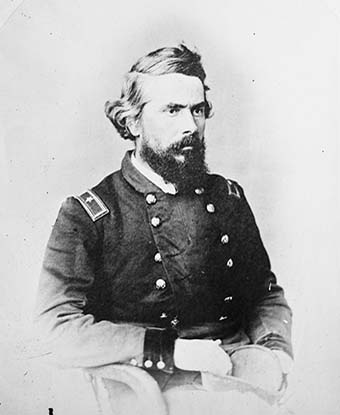Last updated: December 5, 2019
Person
Truman Seymour

Library of Congress
Truman Seymour’s early life mirrors that of many US Army officers before the Civil War: attendance at the US Military Academy at West Point, service in the Mexican-American War, service in the Seminole Wars, and coastal garrison duty. His last duty station before the crisis of secession was Fort Moultrie on Sullivan’s Island.
At the outbreak of the Civil War at Fort Sumter, Seymour served under Major Robert Anderson in the First US Artillery Regiment as captain of company H. Seymour relieved Captain Abner Doubleday after four hours of commanding the guns firing at the Confederates. Brevetted a major for his service at Fort Sumter, Seymour then commanded the 5th Artillery Regiment at Harrisburg, Pennsylvania.
Seymour, promoted to brigadier general of volunteers in April 1862, was assigned to a brigade within the Army of the Potomac’s V Corps and commanded men during the Peninsula Campaign at the Battles of Mechanicsville and Malvern Hill. After the failed Union campaign on Richmond, Seymour commanded men at the Second Battle of Bull Run (Manassas), the Battle of South Mountain, and the Battle of Antietam (Sharpsburg).
In November 1862, Seymour was reassigned and returned to Charleston Harbor. He landed the first Union forces on Folly Island and reconnoitred the Confederate defenses on Morris Island but was unable to advance further given lack of support from General David Hunter. Once General Quincy A. Gillmore took command of US Army operations in Charleston Harbor, Seymour found a commander willing to move forward and attack the Confederates.
Gillmore’s plan of attack called for Seymour to lead his division across Lighthouse Inlet and land on Morris Island on July 10, 1863, which they executed after a fierce artillery bombardment. A strong Confederate battery, Battery Wagner, however still commanded the northern approach to Morris Island.
Seymour wrote of his decision to use the 54th Massachusetts Volunteer Infantry, an African-American regiment, in the July 18 assault: “It was believed that the Fifty-Fourth was in every respect as efficient as any body of men; it was one of the strongest and best officered, there seemed to be no good reason why it should not be selected for this advance.” None of the commanding Union generals expected the fierce resistance the Union soldiers faced and the resulting heavy casualties.
The assault failed in part because additional support and manpower did not quickly follow once the 54th Massachusetts reached Battery Wagner. Seymour ordered and personally led a second advance on Battery Wagner, suffering a severe wound from a shell fragment. This assault also failed. Seymour recovered from his wound and later commanded the District of Florida where he was defeated in February 1864 at the Battle of Olustee, the largest battle in Florida of the Civil War. He was forced to retreat to Jacksonville. Following the battle, he was relieved of his command and sent back to the Army of the Potomac.
He served during the Battle of the Wilderness in May 1864, part of the Overland Campaign in Virginia, and was captured. After being exchanged, Seymour commanded Union campaigns in the Shenandoah Valley, during the siege of Petersburg, and finally during the Appomattox campaign. A captain at the start of the war at Fort Sumter, Seymour had risen to major general of volunteers and was present when Robert E. Lee surrendered to Ulysses S. Grant at Appomattox Courthouse.
Seymour remained in the Army until 1876 and then retired to Europe, becoming an accomplished watercolor painter. He died in Florence, Italy in 1891 and is buried there.
